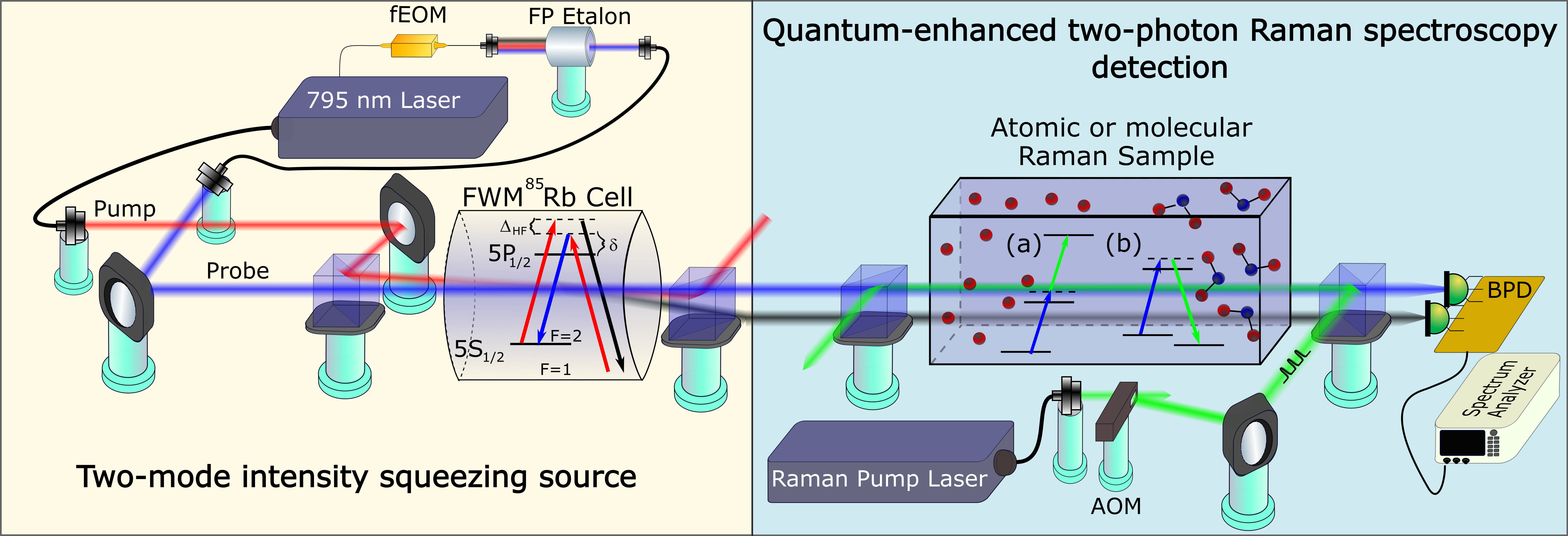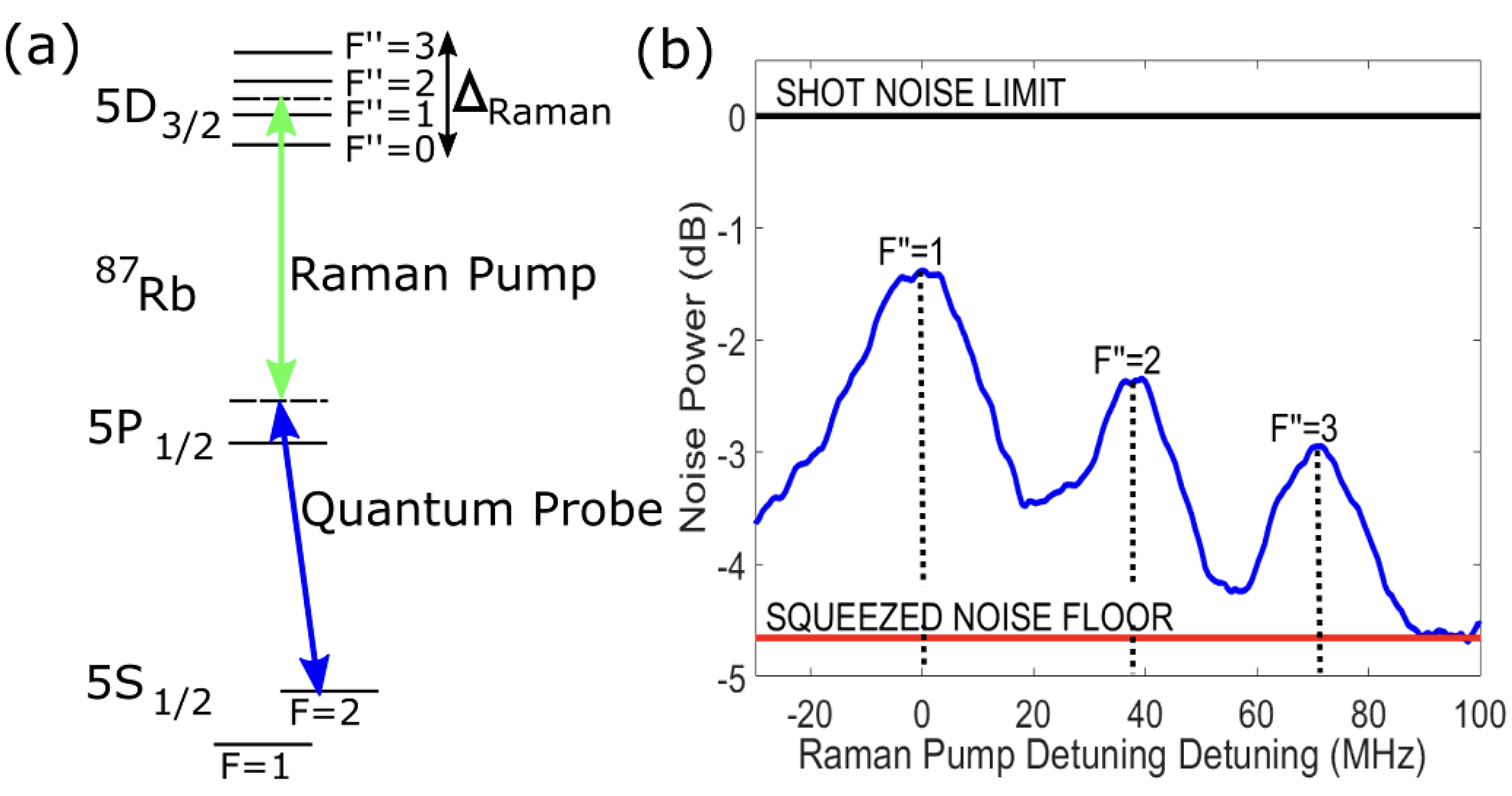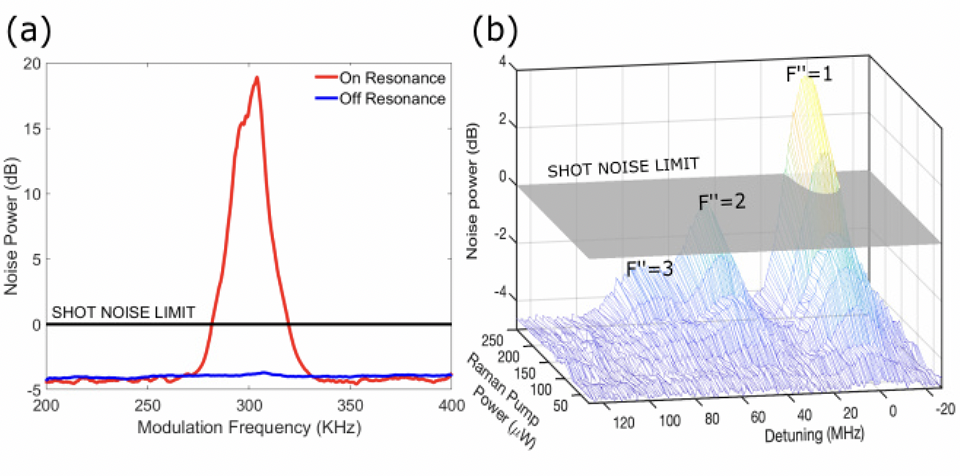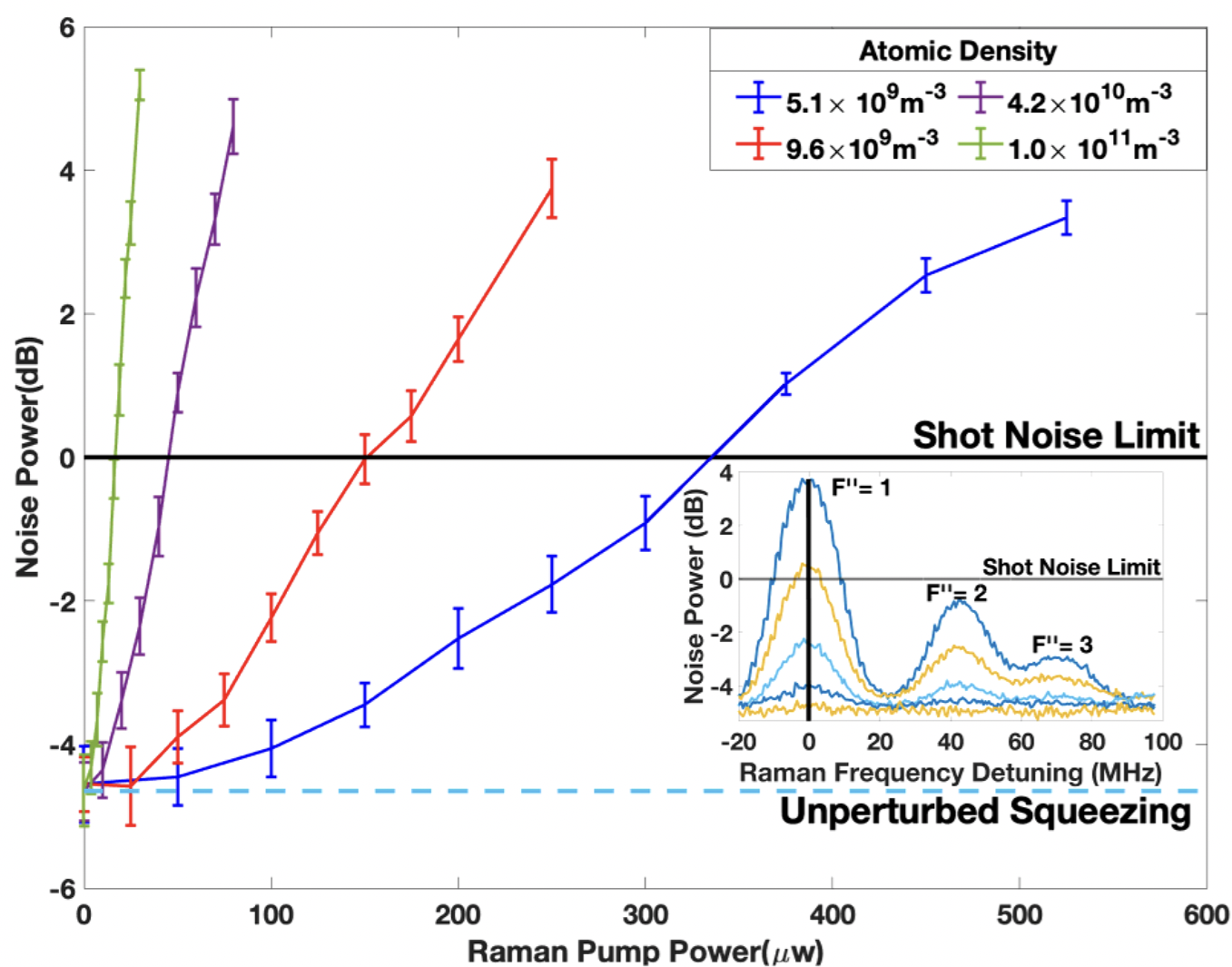Quantum-Enhanced Two-Photon Spectroscopy Using Two-mode Squeezed Light
Abstract
We investigate the prospects of using two-mode intensity squeezed twin-beams, generated in Rb vapor, to improve the sensitivity of spectroscopic measurements by engaging two-photon Raman transitions. As a proof of principle demonstration, we demonstrated the quantum-enhanced measurements of the Rb hyperfine structure with reduced requirements for the Raman pump laser power and Rb vapor number density.
Measurements of the energy level structure of atoms and molecules relied on optical absorption and transmission resonances for over a century, and they are still one of the most common spectroscopical tools Parson (2015). Typically, a broadband or broadly-tunable light source is used to determine the characteristics of various optical transitions through their absorption spectrum. In some applications, however, the amount of light allowed to interrogate the system is limited due to potential temporary or permanent photo-damage Rasmussen et al. (2008), or the available light power is a commodity, like in space exploration or miniaturization Kaushal and Kaddoum (2017). Under such constraints, the measurement sensitivity is ultimately limited by the best attainable signal-to-noise ratio scaling as the square root of the detected photon number Marino et al. (2008); Lawrie et al. (2019). The quantum-enhanced detection methods that take advantage of the non-classical photon correlations, such as squeezing, can boost measurement sensitivity beyond this classical shot noise limit, and thus offer a promising pathway towards performance improvements in the situations where the further increases in the optical power of the probe has negative implicaitons Chua et al. (2014); Taylor and Bowen (2016). For example, intensity squeezed light has been used to overcome quantum shot noise limit in measurements of living systems Taylor et al. (2013); Rasmussen et al. (2008); Jermyn et al. (2016), reducing overall power requirements. However, many squeezed light sources are only available at limited ranges of wavelength and usually are not easily tunable, which limits their applicability for spectroscopy.

In this paper, we propose a method to circumvent the problem of limited tunability of squeezed light sources by measuring two-photon Raman resonances, formed by a fixed-frequency quantum probe and tunable classical pump. In these experiments we use intensity-squeezed twin beams, generated by four-wave mixing (FWM) in warm Rb vapors McCormick et al. (2008); Boyer et al. (2008); Lawrie et al. (2019); Wu et al. (2019). Such twin-beams share quantum fluctuations, and thus their intensity difference allows measurements of small absorption signals below the shot noise limit. Previous experiments demonstrated dB of differential intensity noise reduction below the shot noise limit McCormick et al. (2008); Glorieux et al. (2010), and have been applied for various quantum-enhanced sensing applications Lawrie et al. (2019); Anderson et al. (2017); Prajapati and Novikova (2019). However, since the efficient generation of twin beams is confined to a small frequency range near the Rb atomic resonances Pooser et al. (2009); Du et al. (2017); Prajapati et al. (2019), such quantum light was not used for spectroscopic applications.
The concept of the proposed quantum-enhanced spectroscopy measurements is shown in Fig. 1. By utilizing two-photon Raman resonances, we can extend the potential quantum advantage of squeezed light into spectral regions for which no such sources are available, using an additional tunable pump field to induce two-photon absorption (or transmission) resonances Fleischhauer et al. (2005); Blaauboer (1997). By tuning the pump frequency and monitoring the resulting change in the quantum probe transmission we can map the positions of the atomic levels. By using a two-mode intensity-squeezed twin beams, we can increase the sensitivity of the absorption measurements, thus softening the laser power requirements and/or concentration of the probed material. Such coupling can be performed in either a ladder or configurations, shown in Fig. 1 (a) and (b), respectively. The ladder configuration is particularly well-suited for studies of highly excited states of atoms, such as Rydberg states Simons et al. (2019), or as a multi-photon spectroscopy tool Michael et al. (2019); Hendrickson et al. (2010). The -configuration is attractive for spectroscopic measurements of the vibrational states of molecules Olson et al. (2006), and can lead to improved performance in such applications as trace gas detection, bio-sensing, and molecular characterization Parson (2015); Michael et al. (2019); Virga et al. (2019); Thiel (2001).
Here we present a proof-of-principle demonstration of the proposed method in which we were able to detect the spectrum of the 5D3/2 state in 87Rb via two-photon Raman resonances in the ladder configuration A.S.Zibrov et al. (2002); Akulshin et al. (2009); Prajapati et al. (2018), and experimentally show that the use of the two-mode squeezed light allowed us to reduce the minimum required pump power by approximately a factor of for the same signal to noise ratio. In these experiments we coupled one of the squeezed twin-beams (probe) with the Raman pumping field in a ladder configuration to probe the excited state, level diagram shown in Fig. 2(a).
The schematic of the experimental setup is shown in Fig. 1, with more details available in Ref. Prajapati et al. (2019). Intensity-squeezed twin-beams are generated by mixing the strong pump field (average power 200 mW, beam diameter at the cell 0.45mm) and the weak probe field (average power 40 W, beam diameter at the cell 0.34mm) at an angle of 4 mrad in the 85Rb vapor cell, maintained at the temperature 106oC (labeled “FWM 85Rb Cell” in the diagram). After the cell, the pump beam is filtered out using a polarizing beam splitter, and the amplified probe and newly generated conjugate beams display approximately dB of relative intensity noise reduction below the shot noise limit. To optimize the squeezing performance, the pump field is tuned approximately GHz above the transition of 85Rb, resulting in the probe field being detuned by approximately GHz above the transition of 87Rb, ensuring no noticeable resonant absorption of the probe field by the 87Rb atoms.
To perform the quantum-enhanced spectroscopy of the level, we focused the squeezed twin-beams into a second cell (length mm, diameter mm), containing isotopically enriched 87Rb vapor for the spectroscopy measurements. The counter-propagating Raman pump optical field (762.1068 nm), produced by a tunable Ti:sapph laser, overlapped at a small angle with only the probe field. When the frequency sum of the probe and Raman pump laser matched the two-photon transition frequency to the 5D3/2 excited state, the probe intensity dropped slightly due to the ladder-type Raman absorption. To achieve sub-shot noise regime, we record the difference between the intensities of both probe and conjugate twin beams using a balanced photo-detector (BPD), from which the current was read out by a spectrum analyzer (SA).

We can estimate the effect of Raman absorption on the intensity squeezing between the probe and conjugate optical fields by using a simplified model that traces the evolution of the annihilation operators for these fields (denoted and , correspondingly) first through the FWM cell and then through the spectroscopy cell, starting with a coherent state for the input probe field, and a coherent vacuum for the input conjugate field. First, we describe the generation of the two-mode quantum field in the FWM process via the following transformation:
| (1) | |||||
where is the two-mode squeezing parameter, related to the gain of the four-wave mixing process as McCormick et al. (2008). The additional probe field losses, associated with the two-photon Raman resonance absorption , can be modeled using a traditional beam splitter model:
| (2) |
where corresponds to the coherent vacuum. In this case the expected normalized variance of the differential quantum noise can be expressed as following, assuming shot-noise limited input probe field Jasperse (2010):
Away from the Raman absorption resonance (), the measured noise is determined by the last term that represents the undisturbed FWM two-mode squeezing. Increasing absorption results in sharp noise increase, dominated by the first term, proportional to the FWM gain .
In these and following measurements, both probe and conjugate beams travel parallel through the spectroscopy cell to minimize the difference between their optical losses unrelated to the Raman absorption of the probe field. Fig. 2(b) shows the example of the differential intensity noise measurements after the spectroscopy 87Rb cell while the Raman pump laser frequency was tuned across the two-photon Raman transitions. Three absorption lines, corresponding to the transitions to the states are clearly resolved, even though all the peaks are below the classical shot-noise limit.
The main advantage of using intensity squeezed twin beams for detection of Raman absorption is that it allows detecting weaker resonances due to improved signal to noise ratio and collecting meaningful absorption spectra for samples with lower effective optical depth. In practice, this translates into reduce requirements for either Raman pump optical power, or the atomic concentration.

To further boost the measurement sensitivity, we modulated the intensity of the Raman pump at kHz using an acoustic-optic modulator (AOM), and then monitored any changes in the probe intensity at this modulation frequency. Depending on the proximity to the two-photon resonance and Raman pump power, the peak amplitude will change. The example of recorded noise spectrum on an off the two-photon transition are shown in Fig. 3(a), red trace for resonant conditions and blue trace for off resonant. By tracing the peak amplitude, we can obtain the Raman absorption spectrum, similar to that in Fig. 2(b), but with significantly reduced requirement for the Raman pump power compared to the cw case. Fig. 3(b) shows the measurements of the recorded resonances for different powers of the Raman pump laser. It is easy to see that the resonance amplitudes fall quickly with the reduction of the pump power, thus making the measurements with weaker Raman pump more challenging. However, the reduced noise floor for the probe absorption measurements allowed us to clearly resolve the resonance structure down to much lower pump powers compare to the classical detection. For example, for the highest pump power in Fig. 3(b), 250 W, only the strongest absorption peak (corresponding to the transition to ) was above the shot noise level, while using squeezed light we were able to clearly resolve all three resonances.
To further explore the potential of the quantum enhanced two-photon Raman spectroscopy, we measured the amplitude of the strongest noise peak corresponding to the optical transition and plotted it as a function of the Raman pump laser power for several different atomic densities of Rb vapor, as shown in Fig. 4. The solid line indicate the detection limit set by the classical shot noise, so any data points below this level are only detectable due to the implemented quantum enhanced detection. For higher atomic densities (, the vapor cell temperature C), the use of squeezed beams allowed us to observe the Raman resonance for the probe powers as low as 4 W compare to the classically-limited value of 20 W. As we decreased the cell temperature, we had to compensate for the reducing number of Rb atoms by increasing the strength of Raman coupling to maintain the similar optical depth. Thus, the power thresholds for both classical and squeezed detection increased for lower atomic densities. Nevertheless, the squeezed optical probe always provided substantial improvement: for example, for the lowest atomic density (, the vapor cell temperature C), nearly the entire trace was below the classical limit, and the peak was detectable for powers as low as 50 W.

While the spectroscopy of the Rb atomic state is hardly an important accomplishment by its own, this experiment is a proof-of-principle demonstration of the proposed quantum enhanced spectroscopy. By adjusting the frequency of the coupling laser we can realize similar quantum enhancement to characterize the states in the spectral region for which squeezing sources are not available. For example, this method can be immediately applied for sensors based on Rydberg atomsMohapatra et al. (2007), in which the response of the highly excited atomic states is often monitored through the change in optical depth for one of the low-level transitions. Moreover, for many such applications it is desirable to keep the power of such optical probe to a minimum to avoid power broadening, providing additional motivation for relying on squeezing to reduce measurement noise.
Potentially even more far-reaching applications can be achieved for quantum enhanced spectroscopy of molecular samples. In this case one can use an alternative configuration, shown in Fig. 1 (b), to probe two-photon transitions between the ground state roto-vibrational molecular levels, in a manner similar to stimulated Raman scattering absorption, also known as the inverse Raman effect Jones and Stoicheff (1964); Friedrich (1982). This would produce a squeezing enhanced Raman spectra for potential use in biology or chemistry Nandakumar et al. (2009), particularly for trace gasses monitoring Farrow and Rakestraw (1992). While the strength of Raman transition for an individual molecule is much lower than for a Rb atom, potentially many more molecules can contribute into total absorption to compensate for weaker transition strength in molecules. Also, considering that most molecular samples have Raman transitions in the IR spectral region, one may consider alternative sources of squeezing at higher wavelength. For example, squeezed light at telecom wavelength has been generated in fibers, using the optical Kerr effect Hui and O’Sullivan (1996). The highest squeezing has been achieved in PPKTP crystals using frequency down conversion at 1064 nm Andersen et al. (2016). Finally, other alkali metals, in particularly cesium, can be explored for FWM intensity squeezing generation Ma et al. (2017).
In conclusion, we proposed a method of using a fixed-frequency source of squeezed light to improve the sensitivity of the spectroscopic measurement via two-photon Raman resonances. In this proof-of-principle demonstration we were able to detect the level structure of the state of 87Rb by means of two-photon Raman absorption resonances with the detection noises 5 dB below the classical shot noise limit using a source of two-mode intensity-squeezed light based on four-wave mixing in 85Rb vapor cell.
Our data demonstrates the clear advantage of using non-classical light as we were able to reduce both pump power and Rb atomic density thresholds and observation of Raman resonances imperceptible for the shot-limited case.
For example, for the room temperature (Rb density ) the minimum required pump power dropped from W at the shot noise limit to W. Similarly, for the W pump power we were able to resolve the resonances at Rb density as low as , a factor of 7 reduction from the estimated for a shot-noise limited measurements. Thus, we believe that such quantum enhanced spectroscopy will find many applications, from precise measurement of the energy level structure of highly excited atoms, such as Rydberg atoms, to enhanced detection of molecules for trace gas detection and biological sensing.
Funding: Air Force Office of Scientific Research (FA9550-19-1-0066).
Acknowledgments: We would like to thank Eugeniy Mikhailov and Nathan Kidwell for useful discussions and help with the experiment.
Disclosures: The authors declare no conflicts of interest.
References
- Parson (2015) W. W. Parson, Modern Optical Spectroscopy With Exercises and Examples from Biophysics and Biochemistry (Springer, 2015).
- Rasmussen et al. (2008) M. B. Rasmussen, L. B. Oddershede, and H. Siegumfeldt, Applied and Environmental Microbiology 74, 2441 (2008), ISSN 0099-2240, eprint https://aem.asm.org/content/74/8/2441.full.pdf, URL https://aem.asm.org/content/74/8/2441.
- Kaushal and Kaddoum (2017) H. Kaushal and G. Kaddoum, IEEE Communications Surveys Tutorials 19, 57 (2017).
- Marino et al. (2008) A. M. Marino, V. Boyer, R. C. Pooser, P. D. Lett, K. Lemons, and K. M. Jones, Phys. Rev. Lett. 101, 093602 (2008), URL https://link.aps.org/doi/10.1103/PhysRevLett.101.093602.
- Lawrie et al. (2019) B. J. Lawrie, P. D. Lett, A. M. Marino, and R. C. Pooser, ACS Photonics 6, 1307 (2019), eprint https://doi.org/10.1021/acsphotonics.9b00250, URL https://doi.org/10.1021/acsphotonics.9b00250.
- Chua et al. (2014) S. S. Y. Chua, B. J. J. Slagmolen, D. A. Shaddock, and D. E. McClelland, Classical and Quantum Gravity 31, 183001 (2014), URL https://doi.org/10.1088%2F0264-9381%2F31%2F18%2F183001.
- Taylor and Bowen (2016) M. A. Taylor and W. P. Bowen, Physics Reports 615, 1 (2016), ISSN 0370-1573, quantum metrology and its application in biology, URL http://www.sciencedirect.com/science/article/pii/S0370157315005001.
- Taylor et al. (2013) M. A. Taylor, J. Janousek, V. Daria, J. Knittel, B. Hage, H.-A. Bachor, and W. P. Bowen, Nature Photonics 7, 229–233 (2013), URL https://www.nature.com/articles/nphoton.2012.346.
- Jermyn et al. (2016) M. Jermyn, J. Desroches, K. Aubertin, K. St-Arnaud, W.-J. Madore, E. D. Montigny, M.-C. Guiot, D. Trudel, B. C. Wilson, K. Petrecca, et al., Physics in Medicine and Biology 61, R370 (2016), URL https://doi.org/10.1088/0031-9155/61/23/r370.
- McCormick et al. (2008) C. F. McCormick, A. M. Marino, V. Boyer, and P. D. Lett, Phys. Rev. A 78, 043816 (2008), URL http://link.aps.org/doi/10.1103/PhysRevA.78.043816.
- Boyer et al. (2008) V. Boyer, A. M. Marino, R. C. Pooser, and P. D. Lett, Science 321, 544 (2008), URL http://link.aps.org/doi/10.1103/PhysRevA.78.043816.
- Wu et al. (2019) M.-C. Wu, B. L. Schmittberger, N. R. Brewer, R. W. Speirs, K. M. Jones, and P. D. Lett, Opt. Express 27, 4769 (2019), URL http://www.opticsexpress.org/abstract.cfm?URI=oe-27-4-4769.
- Glorieux et al. (2010) Q. Glorieux, L. Guidoni, S. Guibal, J.-P. Likforman, and T. Coudreau, in Quantum Optics, edited by V. N. Zadkov and T. Durt, International Society for Optics and Photonics (SPIE, 2010), vol. 7727, pp. 9 – 16, URL https://doi.org/10.1117/12.854953.
- Anderson et al. (2017) B. E. Anderson, B. L. Schmittberger, P. Gupta, K. M. Jones, and P. D. Lett, Phys. Rev. A 95, 063843 (2017), URL https://link.aps.org/doi/10.1103/PhysRevA.95.063843.
- Prajapati and Novikova (2019) N. Prajapati and I. Novikova, Opt. Lett. 44, 5921 (2019), URL http://ol.osa.org/abstract.cfm?URI=ol-44-24-5921.
- Pooser et al. (2009) R. C. Pooser, A. M. Marino, V. Boyer, K. M. Jones, and P. D. Lett, Opt. Express 17, 16722 (2009), URL http://www.opticsexpress.org/abstract.cfm?URI=oe-17-19-16722.
- Du et al. (2017) J. Du, L. Cao, K. Zhang, and J. Jing, Applied Physics Letters 110, 241103 (2017).
- Prajapati et al. (2019) N. Prajapati, N. Super, N. R. Lanning, J. P. Dowling, and I. Novikova, Opt. Lett. 44, 739 (2019), URL http://ol.osa.org/abstract.cfm?URI=ol-44-4-739.
- Fleischhauer et al. (2005) M. Fleischhauer, A. Imamoglu, and J. P. Marangos, Rev. Mod. Phys. 77, 633 (2005), URL http://link.aps.org/doi/10.1103/RevModPhys.77.633.
- Blaauboer (1997) M. Blaauboer, Phys. Rev. A 55, 2459 (1997), URL https://link.aps.org/doi/10.1103/PhysRevA.55.2459.
- Simons et al. (2019) M. T. Simons, A. H. Haddab, J. A. Gordon, D. Novotny, and C. L. Holloway, IEEE Access 7, 164975 (2019).
- Michael et al. (2019) Y. Michael, L. Bello, M. Rosenbluh, and A. Pe’er, npj Quantum Information 5, 81 (2019), ISSN 2056-6387, URL https://doi.org/10.1038/s41534-019-0197-0.
- Hendrickson et al. (2010) S. M. Hendrickson, M. M. Lai, T. B. Pittman, and J. D. Franson, Phys. Rev. Lett. 105, 173602 (2010), URL https://link.aps.org/doi/10.1103/PhysRevLett.105.173602.
- Olson et al. (2006) A. J. Olson, E. J. Carlson, and S. K. Mayer, American Journal of Physics 74, 218 (2006), eprint https://doi.org/10.1119/1.2173278, URL https://doi.org/10.1119/1.2173278.
- Virga et al. (2019) A. Virga, C. Ferrante, G. Batignani, D. De Fazio, A. D. G. Nunn, A. C. Ferrari, G. Cerullo, and T. Scopigno, Nature Communications 10, 3658 (2019), ISSN 2041-1723, URL https://doi.org/10.1038/s41467-019-11165-1.
- Thiel (2001) C. W. Thiel, in Semantic Scholar (2001).
- A.S.Zibrov et al. (2002) A.S.Zibrov, M.D.Lukin, L.Hollberg, and M.O.Scully, Phys. Rev. A 65, 051801 (2002).
- Akulshin et al. (2009) A. M. Akulshin, R. J. McLean, A. I. Sidorov, and P. Hannaford, Opt. Express 17, 22861 (2009), URL http://www.opticsexpress.org/abstract.cfm?URI=oe-17-25-22861.
- Prajapati et al. (2018) N. Prajapati, A. M. Akulshin, and I. Novikova, J. Opt. Soc. Am. B 35, 1133 (2018), URL http://josab.osa.org/abstract.cfm?URI=josab-35-5-1133.
- Jasperse (2010) M. Jasperse, Master’s thesis, The University of Melbourne (2010).
- Mohapatra et al. (2007) A. K. Mohapatra, T. R. Jackson, and C. S. Adams, Phys. Rev. Lett. 98, 113003 (2007), URL https://link.aps.org/doi/10.1103/PhysRevLett.98.113003.
- Jones and Stoicheff (1964) W. J. Jones and B. P. Stoicheff, Phys. Rev. Lett. 13, 657 (1964), URL https://link.aps.org/doi/10.1103/PhysRevLett.13.657.
- Friedrich (1982) D. M. Friedrich, Journal of Chemical Education 56, 472 (1982).
- Nandakumar et al. (2009) P. Nandakumar, A. Kovalev, and A. Volkmer, New Journal of Physics 11, 033026 (2009).
- Farrow and Rakestraw (1992) R. L. Farrow and D. J. Rakestraw, Science 257, 1894 (1992), ISSN 0036-8075, eprint https://science.sciencemag.org/content/257/5078/1894.full.pdf, URL https://science.sciencemag.org/content/257/5078/1894.
- Hui and O’Sullivan (1996) R. Hui and M. O’Sullivan, Electronics Letters 32, 2001 (1996).
- Andersen et al. (2016) U. L. Andersen, T. Gehring, C. Marquardt, and G. Leuchs, Physica Scripta 91, 053001 (2016), URL https://doi.org/10.1088%2F0031-8949%2F91%2F5%2F053001.
- Ma et al. (2017) R. Ma, W. Liu, Z. Qin, X. Jia, and J. Gao, Phys. Rev. A 96, 043843 (2017), URL https://link.aps.org/doi/10.1103/PhysRevA.96.043843.